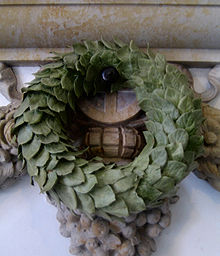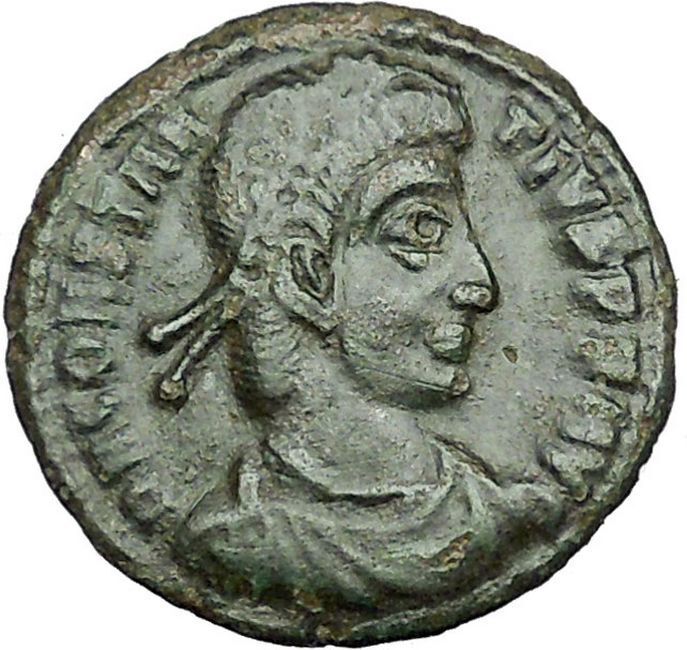|
Constantine II ‘Junior’ – Caesar: 316-337 A.D. and Roman Emperor: 337-340 A.D.
Son of Constantine I ‘The Great’
Bronze AE3 17mm (2.40 grams) Struck at the mint of Rome 321 A.D.
Reference: RIC VII 243v
CONSTANTINVS IVN NOB C, laureate, cuirassed bust right
CAESARVM NOSTRORVM around VOT X within wreath. Mintmark: RT.
You are bidding on the exact item pictured, provided with a Certificate of Authenticity and Lifetime Guarantee of Authenticity.
 The wreath was a symbol of victory in ancient Greek and Roman times, and references to it are still used in modern English language, as some may term it to be a “victory wreath.” A laurel wreath, oak wreath or wreath is a circular wreath made of interlocking branches and leaves of the bay laurel (as in laurel wreath) (Laurus nobilis, Lauraceae), an aromatic broadleaf evergreen; or branches and leaves of other plants. In Greek mythology, Apollo is represented wearing a laurel wreath on his head. A wreath made of oak has connections to Jupiter, the Roman equivalent of Zeus, as his sacred tree was the oak. In ancient Greece wreaths were awarded to victors, both in athletic competitions, including the ancient Olympics made of wild olive-tree known as “kotinos” (κότινος), (sc. at Olympia) and in poetic meets; in Rome they were symbols of martial victory, crowning a successful commander during his triumph. The wreath was a symbol of victory in ancient Greek and Roman times, and references to it are still used in modern English language, as some may term it to be a “victory wreath.” A laurel wreath, oak wreath or wreath is a circular wreath made of interlocking branches and leaves of the bay laurel (as in laurel wreath) (Laurus nobilis, Lauraceae), an aromatic broadleaf evergreen; or branches and leaves of other plants. In Greek mythology, Apollo is represented wearing a laurel wreath on his head. A wreath made of oak has connections to Jupiter, the Roman equivalent of Zeus, as his sacred tree was the oak. In ancient Greece wreaths were awarded to victors, both in athletic competitions, including the ancient Olympics made of wild olive-tree known as “kotinos” (κότινος), (sc. at Olympia) and in poetic meets; in Rome they were symbols of martial victory, crowning a successful commander during his triumph.
The wreath symbol was used often on ancient Greek and Roman coins. The wreath on ancient Roman coins is often depicted being held by Jupiter’s (Zeus’) sacred bird, the eagle, and also Victory (Nike) and by other deities less often; and many coins with emperors depicted wearing it; and at times, entire designs being surrounded by a wreath.
In common modern idiomatic usage it refers to a victory. The expression “resting on one’s laurels” refers to someone relying entirely on long-past successes for continued fame or recognition, where to “look to one’s laurels” encourages an individual to take inspiration from past achievements to conquer a fresh task.

Constantine II ‘Junior’ – Caesar: 316-337 A.D. and Roman Emperor: 337-340 A.D.
| Son of Constantine the Great and Fausta | Brother of Constantius II, Constans, Constantina (wife of Hanniballianus & Constantius Gallus) and Helena the Younger (wife of Julian II) | Half-brother of Crispus | Half-cousin of Delmatius, Hanniballianus, Constantius Gallus, Julian II, Licinius II and Nepotian | Grandson of Constantius I Chlorus, Helena, Maximian and Eutropia | Uncle of Constantia (wife of Gratian) |
Constantine II (Latin: Flavius Claudius Constantinus Augustus; January/February 316 – 340) was Roman Emperor from 337 to 340. Son of Constantine the Great and co-emperor alongside his brothers, his attempt to exert his perceived rights of primogeniture led to his death in a failed invasion of Italy in 340.
The eldest son of Constantine the Great and Fausta, after the death of his half-brother Crispus, Constantine II was born in Arles in February 316 and raised as a Christian. On 1 March 317, he was made Caesar. In 323, at the age of seven, he took part in his father’s campaign against the Sarmatians. At age ten, he became commander of Gaul, following the death of Crispus. An inscription dating to 330 records the title of Alamannicus, so it is probable that his generals won a victory over the Alamanni. His military career continued when Constantine I made him field commander during the 332 campaign against the Goths.
Following the death of his father in 337, Constantine II initially became emperor jointly with his brothers Constantius II and Constans, with the Empire divided between them and their cousins, the Caesars Dalmatius and Hannibalianus. This arrangement barely survived Constantine I’s death, as his sons arranged the slaughter of most of the rest of the family by the army. As a result, the three brothers gathered together in Pannonia and there, on 9 September 337, divided the Roman world between themselves. Constantine, proclaimed Augustus by the troops received Gaul, Britannia and Hispania.
He was soon involved in the struggle between factions rupturing the unity of the Christian Church. The Western portion of the Empire, under the influence of the Popes in Rome, favored Catholicism over Arianism, and through their intercession they convinced Constantine to free Athanasius, allowing him to return to Alexandria. This action aggravated Constantius II, who was a committed supporter of Arianism.
Constantine was initially the guardian of his younger brother Constans, whose portion of the empire was Italia, Africa and Illyricum. Constantine soon complained that he had not received the amount of territory that was his due as the eldest son. Annoyed that Constans had received Thrace and Macedonia after the death of Dalmatius, Constantine demanded that Constans hand over the African provinces, to which he agreed in order to maintain a fragile peace. Soon, however, they began quarreling over which parts of the African provinces belonged to Carthage, and thus Constantine, and which belonged to Italy, and therefore Constans.
Further complications arose when Constans came of age and Constantine, who had grown accustomed to dominating his younger brother, would not relinquish the guardianship. In 340 Constantine marched into Italy at the head of his troops. Constans, at that time in Dacia, detached and sent a select and disciplined body of his Illyrian troops, stating that he would follow them in person with the remainder of his forces. Constantine was engaged in military operations and was killed in an ambush outside Aquileia. Constans then took control of his deceased brother’s realm.
|





 The wreath was a symbol of victory in ancient Greek and Roman times, and references to it are still used in modern English language, as some may term it to be a “victory wreath.” A laurel wreath, oak wreath or wreath is a circular wreath made of interlocking branches and leaves of the bay laurel (as in laurel wreath) (Laurus nobilis, Lauraceae), an aromatic broadleaf evergreen; or branches and leaves of other plants. In Greek mythology, Apollo is represented wearing a laurel wreath on his head. A wreath made of oak has connections to Jupiter, the Roman equivalent of Zeus, as his sacred tree was the oak. In ancient Greece wreaths were awarded to victors, both in athletic competitions, including the ancient Olympics made of wild olive-tree known as “kotinos” (κότινος), (sc. at Olympia) and in poetic meets; in Rome they were symbols of martial victory, crowning a successful commander during his triumph.
The wreath was a symbol of victory in ancient Greek and Roman times, and references to it are still used in modern English language, as some may term it to be a “victory wreath.” A laurel wreath, oak wreath or wreath is a circular wreath made of interlocking branches and leaves of the bay laurel (as in laurel wreath) (Laurus nobilis, Lauraceae), an aromatic broadleaf evergreen; or branches and leaves of other plants. In Greek mythology, Apollo is represented wearing a laurel wreath on his head. A wreath made of oak has connections to Jupiter, the Roman equivalent of Zeus, as his sacred tree was the oak. In ancient Greece wreaths were awarded to victors, both in athletic competitions, including the ancient Olympics made of wild olive-tree known as “kotinos” (κότινος), (sc. at Olympia) and in poetic meets; in Rome they were symbols of martial victory, crowning a successful commander during his triumph. 





